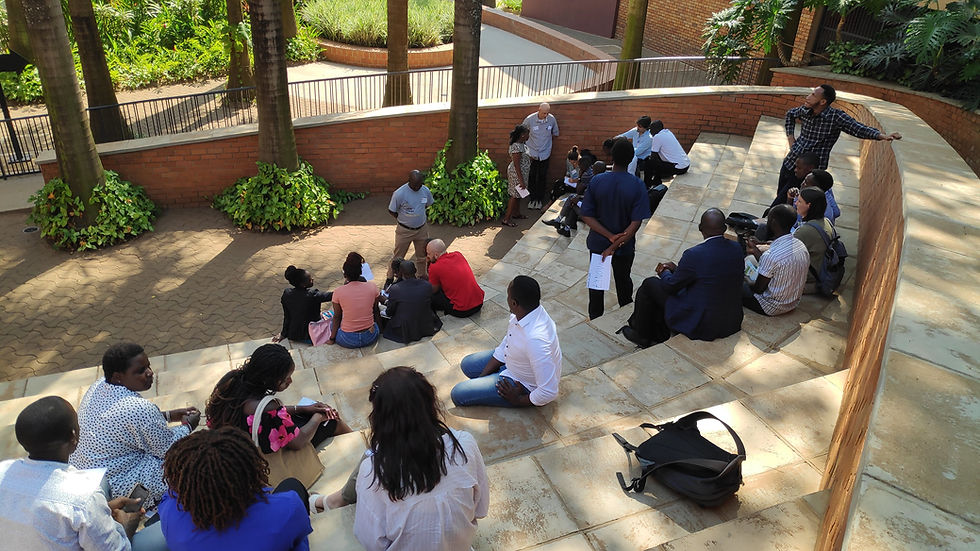Where there is no architect
- info8381132
- Apr 14, 2023
- 3 min read
Meg Collin, Field Officer
Back in January, down by the shores of Lake Mutanda and in the shadow of the Virunga volcanoes I visited a local primary school. The headteacher, a friendly man with medium-level English (he had only completed 4 years of secondary education) showed us around. In each classroom, the children stood up to welcome us, sang a song and then we introduced ourselves. My husband, a doctor, got a good reception, after which the headteacher surveyed the class with: ‘and who wants to be a doctor?’ followed by forty hands shooting into the air. When it came to my turn: ‘I’m an architect.’ Silence. ‘I work in architecture.’ Confusion. ‘I design buildings?’ The headteacher’s face lit up: ‘Ahh, she is a designer. She works with buildings. Now, she is not a builder, so instead she does the decoration.’ And just like that, seven years of higher education were reduced to providing the ornamentation around window frames. The head continued: ‘Now, who wants to be a designer?’ Forty children leapt out their seats and, for a moment, the future of the medical profession looked significantly depleted.

The headteacher introduces us to class P2
It's a comical anecdote, but it does bring into question the role of the architect in Uganda. In a country with one of the highest rates of urbanisation in the world [R1] (second only to Burundi), the need for professional skills in the built environment is unquestionable. However, when the number of registered architects per capita is 137 times less than that of the UK [R2], the profession is stretched. For generations, people have farmed small plots of land and lived in village huts without the need for either architect or engineer, but the same approach cannot be applied today. The division of family farm land among multiple children results in plots too small to sustain the next generation, which is one of several reasons prompting young Ugandans to move to the city. In urban settings, endless informal development is unsustainable: civil infrastructure such as water, wastewater, road and power systems are essential for the health and well-being of the population and a higher density is required (including multi-storey buildings) to ensure that people can buy food and earn the money to pay for it without needing to travel great distances.

The suburbs of the city are a mixture of traditional huts and more ‘modern’ structures, but service provision often lags behind.
Architecture is not the first profession to go through this problem. In sub-Saharan Africa the need for medical professionals is being met by training thousands of clinical officers – who have a shorter training programme that teaches them to treat the majority of common conditions by following protocols, without the in-depth physiological knowledge covered by a full course. The doctors (much fewer in number) are then required to solve the problems that protocols can’t. Perhaps architecture needs to go through a similar shift, where some reach the full extent of training but many complete a shorter course and learn based on protocols. The fully-fledged architects become mentors to these technicians, designing the larger-scale master plans to tackle challenging sites – which generally speaking can’t be addressed by replicable design – and the simpler problems can be solved through practical guidelines.

Partner organisation EMI Uganda helps to train and mentor young professionals in architecture (photo: B. Smith, EMI CA)
It’s not in our remit to redesign educational programmes, but it does help us think about how best to frame the schools design guide. It should be comprehensible to a technician (such as the district engineer) or layperson (such as a prospective school director) and should offer practical and replicable solutions that can be adapted to a variety of sites. It should prioritise the biggest gains, while also recommending the employment of trained consultants to solve whatever challenges are unique to a particular brief.
And what about the architect? Urbanist and affordable housing expert Fatou Dieye [R3] calls for ’a new breed of architect, a hybrid architect/environmental-urbanist-planner-value-chain expert, capable of designing the [building] as well as the specific planning, production and construction processes that determine its suitability to the… context.’
Part of our role is to strengthen architectural education within East Africa and support those training this new generation of designers.
Resources
[R1] https://worldpopulationreview.com/country-rankings/most-urbanized-countries [R2] Guardian table https://www.theguardian.com/cities/2018/jun/14/is-ugandas-critical-shortage-of-architects-costing-lives
[R3] Dieye, F., 2018. The Land of a Thousand Hills: Rwanda's New Urban Agenda. Architectural Design, 88 (4), pp.112-119.




Comments